
User manual
– SYSTOE
14 168
Rev. G
Page 7/38
3.2
Photo plethysmography (PPG) sensor
The PPG sensor is composed of an emitter and a photodetector (Infrared).
The interaction of light with biological tissue is complex and includes the
optical processes of multiple scattering, absorption, reflection, transmission
and fluorescence.
Light received by the photodetector is affected by the blood volume, blood
vessel wall movement and the orientation of red blood cells (RBC).
The pulsatile component of the PPG waveform (‘AC’ component) has its
fundamental frequency depending on heart rate.
This AC component is superimposed onto a large quasi-continuous
component
(‘DC’ component) that relates to the tissues and to the average
blood volume. This DC component varies slowly due to respiration,
vasomotor activity and vasoconstrictor waves, Traube Hering Mayer (THM)
waves and thermoregulation.
4
Main features
The
SysToe
is a portable, lightweight instrument which measures the
systolic pressure in the digit in a non-invasive way.
The principal features of the
SysToe
are the followings:
Automatic inflation and deflation the cuffs.
Display the PPG sensor signal and the systolic pressure (SYS) in the
toe or digit.
Display the TBI (Toe Brachial Index or Finger Brachial Index) once
the user inputs the systolic brachial pressure.
Can store up to 32 examinations.
Enables data to be transmitted to a computer via the USB port for
their storage and the printout of examination reports.
5
Applied parts
Infrared sensor.
Infrared sensor









































